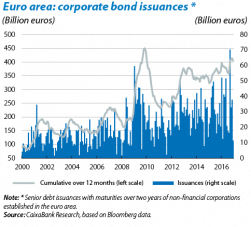The United States bond market: Bernanke's view
Ben Bernanke, Chairman of the Federal Reserve (Fed) of the USA, recently gave a speech dealing with two questions of concern to many investors: why are US bond yields at such a low level and how will they perform over the coming years?
To answer the first question, Bernanke proposed an analysis in which long-term yields are decomposed into three components: (i) the inflation expected by bond market participants, (ii) the path of the short-term real rate expected by these agents and (iii) the term premium, namely the premium demanded to compensate the time-related risk (i.e. investing long instead of short). This decomposition is represented in the first graph.
Bernanke associated the stability recorded by the first component with the high credibility of the Federal Reserve's commitment to price stability. The anchoring of inflation expectations has been a key factor influencing long-term interest rates over the last few decades but has remained stable since 2007-2008. However, he pointed out that, since this date, the short-term real interest rate has been influenced by the exceptional nature of monetary policy and expectations of how this policy will evolve (a factor that is, in turn, closely related to the economic outlook). Market participants expect real short-term rates to remain around zero for some time, expectations that are strengthened by the monetary authority's own messages. Lastly, the term premium component lies behind most of the fall observed in nominal yields since 2010. This is not surprising as it coincides with the extensions of large-scale long-term bond purchases (QE2 and QE3) and with operations to extend the maturities of the public debt portfolio (Operation Twist).
In response to the second question, Bernanke outlined a relatively reassuring main scenario. He pointed out that, if the economic recovery continues at a moderate pace, unemployment declines slowly and inflation expectations remain near 2%, then long-term yields will rise gradually toward more normal levels over the next few years. Based on different estimates, he therefore stated that long-term yields will increase by between 200 and 300 basis points between now and 2017.
However, he also admitted that there are significant risks of reality deviating from this main scenario, both upward and downward. Once again, he revealed what particularly concerned him on stressing that any sharp rise in yields is not desirable within a context of a slow recovery since it would harm economic activity and financial stability. He stated that, given such a situation, the institution might once again resort to its balance sheet tools.
There are at least two risks that Bernanke did not deal with explicitly: (i) a possible unanchoring of investors' inflation expectations and, (ii) within the medium term, the failure to achieve any convincing political agreement related to the country's fiscal challenges. The impact of either of these would be negative insofar as they would generate upward tensions on yields and a much more volatile and erratic environment.




